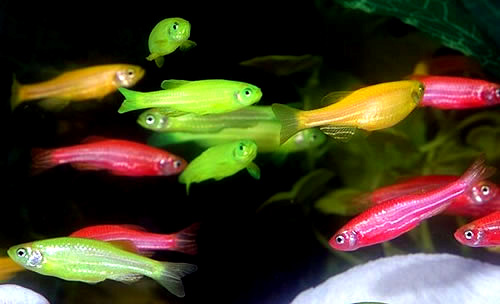science stuff: glowing animals – the light within
 We all know that stuff that glows is cool – it’s one of those truths you learn somewhere in primary school when you receive that first glow-in-the-dark sticker. There is some kind of almost primal attraction to that yellowy-green light, those little points of brightness when everything is dark. Modern living has found a way to work glowing ability into stick on stars, watch dials, paint and t-shirts, and now it’s working its way into pets too. GloFish anyone?
We all know that stuff that glows is cool – it’s one of those truths you learn somewhere in primary school when you receive that first glow-in-the-dark sticker. There is some kind of almost primal attraction to that yellowy-green light, those little points of brightness when everything is dark. Modern living has found a way to work glowing ability into stick on stars, watch dials, paint and t-shirts, and now it’s working its way into pets too. GloFish anyone?
There are plenty of creatures out there that glow naturally. When living things glow they do so by a process called bioluminescence. It’s the chemical reaction that famously lights up fireflies (actually beetles) and glow-worms (actually insect larvae.) There are fungi that emit light eerily in the forests and plenty of deep-sea organisms that light up the underwater realm. So glowing is not by any means an unnatural process and exists in a whole range of species and animal types.
The most famous source of biological green glowing is caused by Green Fluorescent Protein (GFP) which was originally isolated from jellyfish. When animals or bacteria that contain GFP are exposed to UV light they glow green. Because the GFP stands out nicely scientists use it widely as a marker for studying the expression of certain genes in a range of animals. By attaching the genetic code for GFP to a particular type of gene they wish to study they can easily see where that gene shows up. In this way the GFP can be thought of as a biological highlighter – it helps to focus on certain genes.
If you read the popular media you could be excused for thinking there are a lot of scientists spending their entire lives in labs for no other purpose than creating glowing animals. Mice, pigs and cats that glow have all been recent additions that emit the green glow. But in each case they have been developed to help gain a better understanding of a complex biological issue.
The glowing cats developed in the United States were never destined to be funky pets. Instead, they were part of a study looking to develop cats immune to feline AIDS, with a view to gaining a better understanding of AIDS generally. Cats were created that carried a gene that might prevent them from developing AIDS, coupled with the GFP gene. The purpose of the GFP gene was to highlight the parts of the cat that carried the anti-AIDS gene – if it glowed it showed that the anti-viral factor had indeed been transferred to those parts of the cat. This is the same for the vast majority of other genetically modified glowing animals – they are created to highlight important genes of proteins in an easy to see way.
While most glowing animals are kept safely in the, some glowing animals are now being sold as pets. It’s important here to make a distinction between research science and a commercial enterprise that uses the techniques that was originally developed for research. It’s a bit like considering surgery – there are lot of doctors who develop a range of lifesaving surgical procedures and then their techniques are used in plastic surgery – not the original context. “Science” is no more responsible for the marketing of glowing animals as pets than it is for the marketing of the iPhone.
At the minute the only glowing animals available to the public are GloFish. They are the world’s first genetically modified pet and are currently only available in the US. But it raises interesting ethical and consumer issues. We know we love glowing things, but should we keep a glowing pet? Is a glowing pet, in fact, any stranger than a glow in the dark star on your ceiling? Both are as unnatural as each other and both are kind of cool.
By Joee Kelk


Truly fascinating! Who would have thought that nature created the light bulb before man. Though I feel kind of bad about those glowing cats.